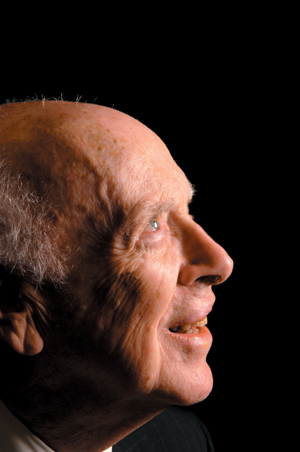|
||
      |
Features ::
Glimpses
 James Dewey Watson, PhB’46, SB’47, was 24, with a PhD in zoology from Indiana University, when he and Francis Crick, a fellow researcher at the University of Cambridge’s Cavendish Laboratory, discovered the double-helix structure of DNA. That was in 1953; in 1962 Watson, Crick, and Maurice Wilkins shared the Nobel Prize “for their discoveries concerning the molecular structure of nucleic acids and its significance for information transfer in living material.” This spring Watson—author of The Double Helix: A Personal Account of the Discovery of the Structure of DNA (1968),past director of the Human Genome Project, and chancellor of Cold Spring Harbor Laboratory—became the first person to have his genome sequenced and made public. Two days after Watson’s genome was posted on a National Institutes of Health database, he arrived at Rockefeller Chapel (“the only church that ever inspired me”) to receive the 2007 Alumni Medal and give the Alumni Weekend’s convocation address. When he sat down for a conversation with television commentator Ray Suarez, AM’93, as part of the weekend program, he was characteristically candid.
James Dewey Watson, PhB’46, SB’47, was 24, with a PhD in zoology from Indiana University, when he and Francis Crick, a fellow researcher at the University of Cambridge’s Cavendish Laboratory, discovered the double-helix structure of DNA. That was in 1953; in 1962 Watson, Crick, and Maurice Wilkins shared the Nobel Prize “for their discoveries concerning the molecular structure of nucleic acids and its significance for information transfer in living material.” This spring Watson—author of The Double Helix: A Personal Account of the Discovery of the Structure of DNA (1968),past director of the Human Genome Project, and chancellor of Cold Spring Harbor Laboratory—became the first person to have his genome sequenced and made public. Two days after Watson’s genome was posted on a National Institutes of Health database, he arrived at Rockefeller Chapel (“the only church that ever inspired me”) to receive the 2007 Alumni Medal and give the Alumni Weekend’s convocation address. When he sat down for a conversation with television commentator Ray Suarez, AM’93, as part of the weekend program, he was characteristically candid.
Natural inheritances: I was born in St. Luke’s Hospital, in 1928 to a family with three paramount values: books, birds, and the Democratic Party. My father brought the books and the birds. As soon as I could walk, he would take me to the public library every Friday night. At the same time, he would take me for bird walks, most frequently in Jackson Park. My strong devotion to intellectual things was helped by the fact that I was a puny boy. I was probably more liked by my teachers than my classmates.
The Chicago advantage: It’s an officers’ training school for thinkers. The primary thing is to reason and get the right conclusion from the premises of facts. So, when I left the University of Chicago, I was an officer.
Eye on the prize: If you’re going into something dangerous, don’t go alone, climb with someone else. Luckily, I found Crick. ... Before you reach the top, when you’re in base camp, you should talk to the other people who are there, who are after the same goal. Without help from our competitors, we couldn’t have done it.
Life lesson: Never go to any party given by someone over the age of 50, especially a dinner party, because they are so boring—because they are concerned with the present and the past and not the future. It’s a good rule if you can avoid everyone over 50. Your life will go faster.
A genome in every garage: The really exciting thing is the complete revolution in the ability to read the messages of the DNA. My DNA has been sequenced [by the biotech company 454 Life Sciences] for a cost of about $1 million. ... I think it will soon approximate a Chevrolet in price. Which means you have the choice of buying a car for your kid or doing his DNA sequence.
Next frontier: Dissect the genetic basis of mental disease—which is so hard to diagnose. Tragically, we have a son with schizophrenia. He was given every [other] diagnosis because you don’t really want to say someone is not likely to have a future. So we never handled him right—we expected more of him. If we had been given the bad news early, it would have been much kinder to our son because not getting the truth meant we were never doing the right thing. I think we can have a genetic diagnosis for every mental condition within ten years—if we really were at war against mental disease. But we’re not really at war against mental disease. One reason is that the average person thinks it’s premature: wait for ten years before you go for it—whereas I know we can do it.
Success factors: Why was I successful? It must be something. I walked fast. ... I still walk fast at nearly 80. So I’m in a hurry—people ask, Why are you so impatient?